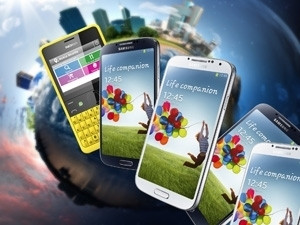
Smartphone growth in SA continues unabated, with the number of smartphones now in use exceeding analysts' expectations and the feature phone - slowly, but surely - becoming extinct.
While there is no question as to whether smartphones will remain on an upward trajectory, experts weigh in on some of the trends local consumers can expect from the "smartphone war" in 2015.
World Wide Worx MD Arthur Goldstuck last year noted there were about 16.3 million smartphones in use in SA at the end of 2013. While this was originally forecast to grow to about 18.1 million by the end of 2014, growth acceleration suggested it could beat the 20 million mark ? a penetration increase from 30% to 40% in a year.
BMI-TechKnowledge director Brian Neilson puts the number of active smartphones in SA at around 23 million as at year-end 2014 - a figure that is up 23% on the December 2013 figure of 19 million. "That means nearly 30% of all active SIMs in the market are in smartphones."
Highs and lows
The low-cost smartphone, which came to the fore in a big way last year, is still king in SA. Goldstuck says the low-end will dominate smartphones in 2015, with reference designs (mainly from Qualcomm) appearing in greater numbers than ever before, especially from the mobile network operators and large retailers.
"We will see pressure on the low-end, where the entry price is currently R549 after having briefly fallen to R450. We'll probably see a return to the sub-R500 level, especially once Firefox phones start entering the market."
Meanwhile, says Goldstuck, top-of-the-range phones may keep rising in price due to the poor exchange rate, but we should see significant competition on price. "Samsung probably realises it priced the Galaxy S5 out of the market."
Neilson says the trend now, is for manufacturers to cover all price points, by continuing to sell previous models at discounted prices. "At the same time, the entry-level price points are still falling, but this trend should start to bottom out as low-end customers desire more/better features."
Goldstuck notes the high-end smartphone market is still a little saturated, with the price of leading flagship devices like Samsung and Apple breeching the R10 000 mark - a situation that presents significant opportunity for slightly less pricey flagships from "second tier" brands like Huawei, Sony and HTC.
Brand plans
In terms of what South Africans can likely expect - apart from the possibility of "big guns" Apple and Samsung surprising the market - Goldstuck says, at this stage, the smartphone war looks for the most part predictable.
"BlackBerry will bring the new Classic into SA, Samsung the Galaxy S6 and the recently launched A7, Huawei will most likely produce a P8 around mid-year, HTC maybe an HTC Two, LG a G4, Apple a 6S, and so on. However, both Apple and Samsung may startle the market, with Apple possibly producing a lower-cost mini (but not too low-cost ? they understand the power of the margin at the high end), and Samsung pulling out the stops to restore technology leadership with the S6."
In what will come as welcome news to charger-bound consumers, industry watchers expect 2015 to see improvements to the smartphone battery. Neilson says the battery factor will take on more importance in the buying criteria mix, and Goldstuck says consumers can expect more innovation in battery and battery management. Here, he says, Samsung and Huawei will continue to lead in management, while Sony and BlackBerry will continue to lead in battery life.
Meanwhile, the doors are still open for new entrants. There is a strong chance Motorola will re-enter the market, says Goldstuck. "If not, Lenovo may well enter in its own right.
"Asus may also enter with a smartphone, but I've yet to see evidence of real commitment to this market. Xiaomi is unlikely to be a major player here for the foreseeable future, as the market is simply too small by itself to justify the scale at which it operates. However, sooner or later someone will see the opportunity to act as local agents."
Neilson says, conceivably, a new player may emerge from the Far East, although any such instances are more likely to come in the form of white-labelled brands from the likes of Vodacom, MTN and Edgars, for example.
Share